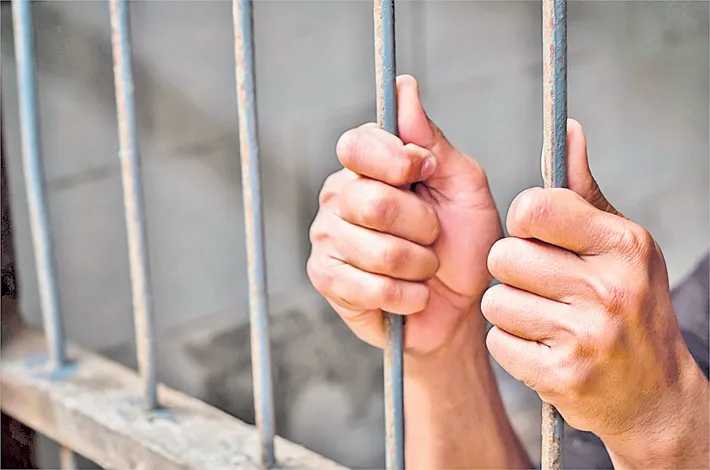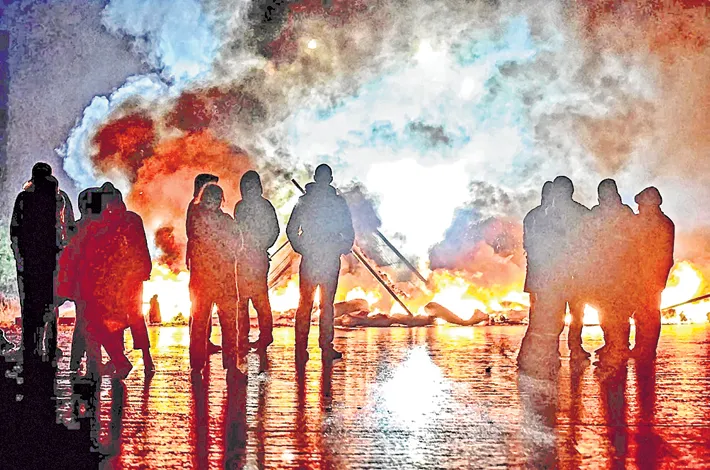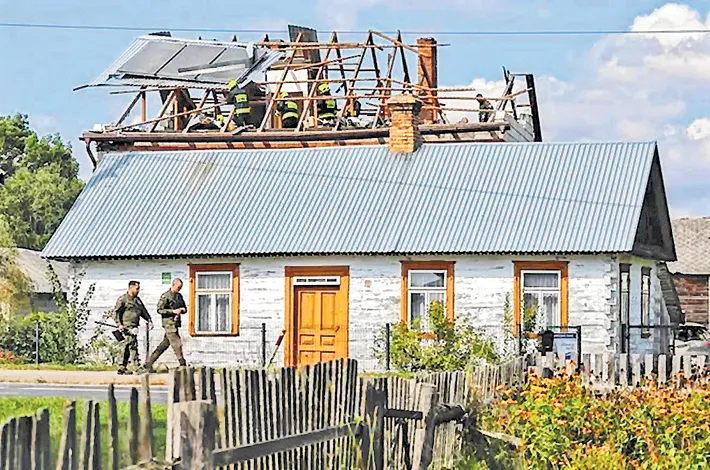The plight of undertrial prisoners in India
29-06-2025 12:00:00 AM

Overcrowding is not merely a logistical issue; it is a humanitarian crisis
- Over 4 lakh undertrial prisoners awaiting trial and not yet convicted
- Tihar Jail and Moradabad District Prison, occupancy rates soar to 400% and 497%, respectively
- IJR 2025 warns the prison population could exceed 6.88 lakh by 2030
- Over 4.7 crore cases pending in Indian courts
As of December 2022, India’s prisons housed approximately 5.7 lakh inmates against a sanctioned capacity of 4.36 lakh 4 lakh are not yet convicted, comprise 76% of the country’s total prison population
India’s prison system is grappling with a profound crisis, as over 400,000 under trial prisoners—individuals awaiting trial and not yet convicted—comprise a staggering 76% of the country’s total prison population.
This alarming statistic, highlighted in the India Justice Report (IJR) 2025, underscores a deep-rooted systemic failure in the criminal justice system. Overcrowded jails, prolonged detentions, and inadequate legal aid have turned pre-trial custody into a form of punishment.
The plight of undertrial prisoners, many of whom languish in jails due to poverty, lack of legal representation, or judicial delays, raises critical questions about justice, human rights, and the state’s commitment to reforming an overburdened system. This analysis explores the causes, consequences, and potential solutions to this crisis, drawing on recent developments and data.
The Scale of the Crisis
As of December 2022, India’s prisons housed approximately 5.7 lakh inmates against a sanctioned capacity of 4.36 lakh, resulting in a national average occupancy rate of 131%. In some facilities, such as Delhi’s Tihar Jail and Moradabad District Prison in Uttar Pradesh, occupancy rates soar to 400% and 497%, respectively. Of this population, 76%—roughly 4.34 lakh individuals—are undertrial, a sharp rise from 66% a decade ago. Uttar Pradesh alone accounts for nearly 94,000 undertrials, followed by Bihar and Maharashtra, which collectively represent 42% of the nation’s undertrial population. The IJR 2025 projects that by 2030, the undertrial population could exceed 5.26 lakh if current trends persist.
This overcrowding is not merely a logistical issue; it is a humanitarian crisis. Undertrials, many of whom are likely innocent, endure prolonged detention in inhumane conditions, often for minor offenses. The data reveals a disturbing trend: 22% of undertrials have been incarcerated for one to three years, and 11,448 have been detained for over five years as of 2022, a threefold increase from 2012. Such extended pre-trial detention effectively turns jails into punitive spaces, violating the principle that individuals are innocent until proven guilty.
Root Causes of the Undertrial Crisis
The undertrial crisis stems from multiple systemic failures. First, judicial backlogs and understaffed courts contribute significantly to prolonged detentions. With over 4.7 crore cases pending in Indian courts, trials often take years to commence, leaving undertrials in limbo. Second, many undertrials, particularly from marginalized communities, cannot afford bail or legal representation. The Parliamentary Standing Committee on Home Affairs noted in March 2025 that 70% of prisoners remain incarcerated simply because they cannot pay bail amounts or fines, despite state prison administrations spending more on their upkeep than the bail required for their release.
Third, the lack of effective legal aid exacerbates the problem. While District Legal Services Authorities (DLSAs) exist to provide free legal assistance, their reach and efficiency are limited. A recent initiative in Maharashtra, launched in 2018 under Chief Minister Devendra Fadnavis, demonstrates the potential of targeted legal aid.
This program, in collaboration with the Azim Premji Foundation, Tata Institute of Social Sciences, and National Law University, Delhi, has aided 20,000 undertrials, securing the release of 9,000 - 45% of those assisted - through legal support and bail facilitation. However, such initiatives remain localized and underfunded, with the Ministry of Home Affairs (MHA) noting that central funds allocated for poor prisoners often go unused due to poor implementation by states.
Additionally, delays in surety verification and inadequate coordination between police, judiciary, and prison authorities further prolong detentions. Former Supreme Court Justice Sanjay Kishan Kaul emphasized that the justice system’s inefficiencies—understaffed police, ineffective legal aid, and overburdened courts—create a vicious cycle that traps undertrials.
Consequences: Human Rights and Recidivism
The consequences of this crisis are dire. Overcrowded prisons, operating at 131% capacity on average, strain resources, leading to inadequate healthcare, sanitation, and rehabilitation programs. Such conditions increase the risk of recidivism, as the IJR 2025 notes, with prolonged detention in dehumanizing environments fostering resentment and criminal behavior rather than reform. The psychological toll on undertrials, many of whom are detained for minor offenses, is immense, with cases of violence and suicide reported in facilities like Tihar Jail and Saket court lock-ups. For instance, in June 2025, a 24-year-old undertrial, Aman Poddar, was killed by fellow inmates in a Delhi court lock-up, highlighting security lapses and the dangers of overcrowding.
The crisis also has international implications. In extradition cases, such as those involving fugitives like Sanjay Bhandari and the Awasty couple, UK courts have cited the risk of torture and inhumane treatment in Indian prisons, particularly Tihar, as grounds for denying extradition. This underscores the global scrutiny on India’s prison conditions and the urgent need for reform.
Steps toward reform
Efforts to address the undertrial crisis have gained traction, though they remain insufficient. The Maharashtra legal aid model, now adopted nationally with central funding, is a promising step. It involves trained social work and legal fellows assisting undertrials with documentation, court procedures, and representation. The program’s success in releasing 9,000 prisoners since 2018 highlights the potential of scaling such initiatives.
Legislative reforms, such as Section 479 of the Bharatiya Nagarik Suraksha Sanhita (replacing Section 436A of the CrPC), allow undertrials to be released on bail after serving half the maximum sentence for non-capital offenses. However, implementation remains patchy, with many undertrials unaware of their rights. The MHA’s directive to states to utilize central funds for bail assistance is another positive move, but its effectiveness depends on state-level action.
Judicial interventions, such as virtual court appearances for high-risk undertrials to reduce security risks, and Supreme Court calls for bail reform, are critical. However, as Justice B R Gavai noted in November 2024, the lack of legal aid continues to trap many undertrials, necessitating a systemic overhaul.
The Path Forward
The undertrial crisis demands a multi-pronged approach. First, expediting judicial processes through increased court staffing and fast-track courts for minor offenses could reduce backlogs. Second, strengthening legal aid by expanding programs like Maharashtra’s and ensuring effective use of central funds is crucial. Third, addressing surety verification delays and simplifying bail processes for indigent prisoners would prevent unnecessary detentions. Finally, prison infrastructure must be upgraded to alleviate overcrowding, with a focus on humane conditions and rehabilitation.
The story of India’s 4 lakh+ undertrial prisoners is not just a statistic; it is a reflection of a justice system failing its most vulnerable. As the IJR 2025 warns, without urgent reforms, the prison population could exceed 6.88 lakh by 2030, with undertrials continuing to bear the brunt. The time for action is now, lest India’s jails remain a symbol of injustice rather than reform.








